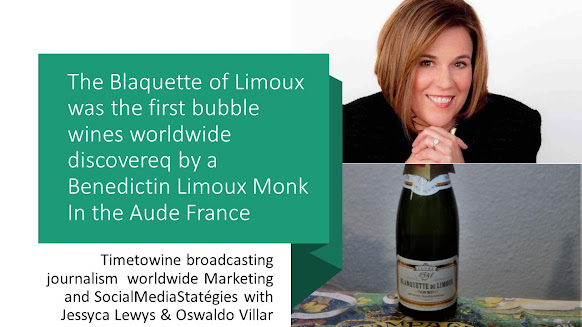#Timetowine La Blaquette de Limoux est le plus ancien vin à Bulles du monde
#JessycaLewis #MBA professeur entrepreneur #university professor #socialmedia #marketingstratégies.
#Aude #County specialties exist such as oysters from Gruissan and Leucate. Olive oil
is also very widespread in the Aude and is a speciality of Bize-Minervois. #Cartagena is a liqueur
marketed by some manufacturers. Finally, the Blanquette de Limoux is a sparkling white wine
popular in the department whose origin dates back to the sixteenth century.
Limoux barely escaped historical relegation as a local
speciality by a flood of Spanish fizz from the other side of the Pyrénées
mountains and is now fighting its corner with an offer of quality sparkling
wines at affordable prices for its sweet traditional Blanquette de Limoux
Methode Ancestrale and dryer Blanquette de Limoux Brut.
“Twenty years ago the quality of Limoux wines in general was
not very good,” said Richard Planas, the director of the AOC Limoux
professional body. “A lot of work has been done and a lot has changed.”
Limoux lies to the south of the Medieval walled city of
Carcassonne, not far from the Mediterranean and the eastern Pyrénées. The area
has plenty of sun and rain while the winds from both the Mediterranean and the
Atlantic Ocean soften the temperature extremes in both summer and winter.
The Roman historian Livy who died in 17 AD mentioned wines
from Limoux, but the first mention of a sparkling wine from the area was found
in 1531 records kept by the Benedictine monks of the abbey of Saint Hilaire,
near the town.
“It is of course difficult to claim being the first,
sparkling wine is a natural effect of yeast and it could have been discovered
at several places around that time,” Planas said.
Other sparkling wines with a long pedigree are the Gaillac
bubbly, also from the southwest, and the Clairette de Die from the northeast.
Legend has it that Dom Pérignon travelled during a
pilgrimage to the Saint-Hilaire abbey - on the way to Santiago de Compostela in
northern Spain - and discovered the process of sparkling wines there.
On return to his abbey of Saint-Pierre d’Hautvillers near
Reims, he started to experiment with the technique on local wines from the
Champagne region with another monk, Dom Thiery Ruinart. Champagne quickly
overshadowed its predecessors.
“Champagne is in another league altogether, both in volume
terms as in price,” said Planas.
Blanquette means “white one” in southern French, a term also
used for a cream sauce in such dishes as the ‘Blanquette de veau’ traditional
veal stew.
In 1975, French vintner groups decided that bubbly wines
from outside the Champagne are should be labelled “Crémant” (creamy) and the
country now knows various varieties such as the Crémant de Bourgogne, Crémant
de Loire, Crémant de Bordeaux, Crémant de Jura and also Crémant de Limoux. The
term crémant may only be used on wine from France and Luxembourg.
These wines were widely consumed in France as a cheaper, and
often regional, alternative to Champagne. But they themselves lost ground to
Cava sparkling wine from Catalonia in Northern Spain, with Barcelona’s
Freixenet as a big brand name, or the Asti Spumante or Prosecco from Italy.
ANT VS SHOVEL
“For us, the biggest competition is from the Cava,” said
Planas. “It is a battle between an ant and a shovel; they make some 300 million
bottles against our 10 million.”
Spanish Cava production makes it the second-biggest growing
area of sparkling wine after Champagne. Since 1986 when Spain joined the
European Economic Community, a forerunner of the EU, the cava found its way
across the mountains and to other countries. Limoux only has limited means to
resist.
There are 7,800 hectares of vines spread over 41 villages
around Limoux, producing sparkling and ‘normal’ wines.
The Blanquette Brut predominantly uses a local grape
variety, the Mauzac. Up to 10 percent of Chenin and Chardonnay are permitted.
The producers harvest and press grapes from various parcels
and start making basis wines with the first fermentation. These are tasted to
determine the blend for the final product.
The blend is put in bottles and a special mixture is added
to provoke a second fermentation that creates the bubbles. This second
fermentation takes nine months, during which the bottles are regularly turned
to let the sediments settle in the neck.
The Crémant de Limoux is made with Chardonnay and Chenin and
some addition of Mauzac and Pinot Noir. The Blanquette Methode Ancestrale uses
only Mauzac, is trickier to make and needs to be bottled in March when the moon
is at a certain point.
No mixtures are added to the bottles at the beginning of the
second fermentation and some sediment remains in the bottle. These ‘pure’
traditional wines are sweeter due to the sugar in Mauzac that fuels the
fermentation.
Cooperative
There are dozens of vintners in the area, producing wines
under the various Limoux AOC and also the wider Languedoc label. The area is
known to be good for Pinot Noir that is used by other red wine makers.
The largest grouping is the cooperative ‘Sieur d’Arques’ ,
named after a local squire who was known to enjoy the jugs of bubbly made by
the St Hillaire monks, and which markets sparkling wines as “Premiere Bulle”
(First Bubbly) in a standard, premium and rosé version.
The cooperative also provided Pinot Noir for the Red Bicycle
wine of E & J Gallo in the United States. But several commercial staff
members were convicted for having supplied a different grape variety.
“The affair has not really damaged Limoux, it was limited to
some commercial staff at the cooperative and not related to the sparkling
wine,” Planas said.
Next to the cooperative there are various firms catering to
specific clients and tastes, such as Bruno Delmaz of Domaine Delmaz who has
taken the route of “bio” ecology friendly wines.
Planas said that while the number of producers has declined
over the decades in a trend from smaller plots to bigger vineyards, there
remains a lively community.
“There are two young vintners who are having their first
year of production this year, there still is new blood.”




Commentaires
Enregistrer un commentaire